In the Deep South, a reenactment for the 21st century
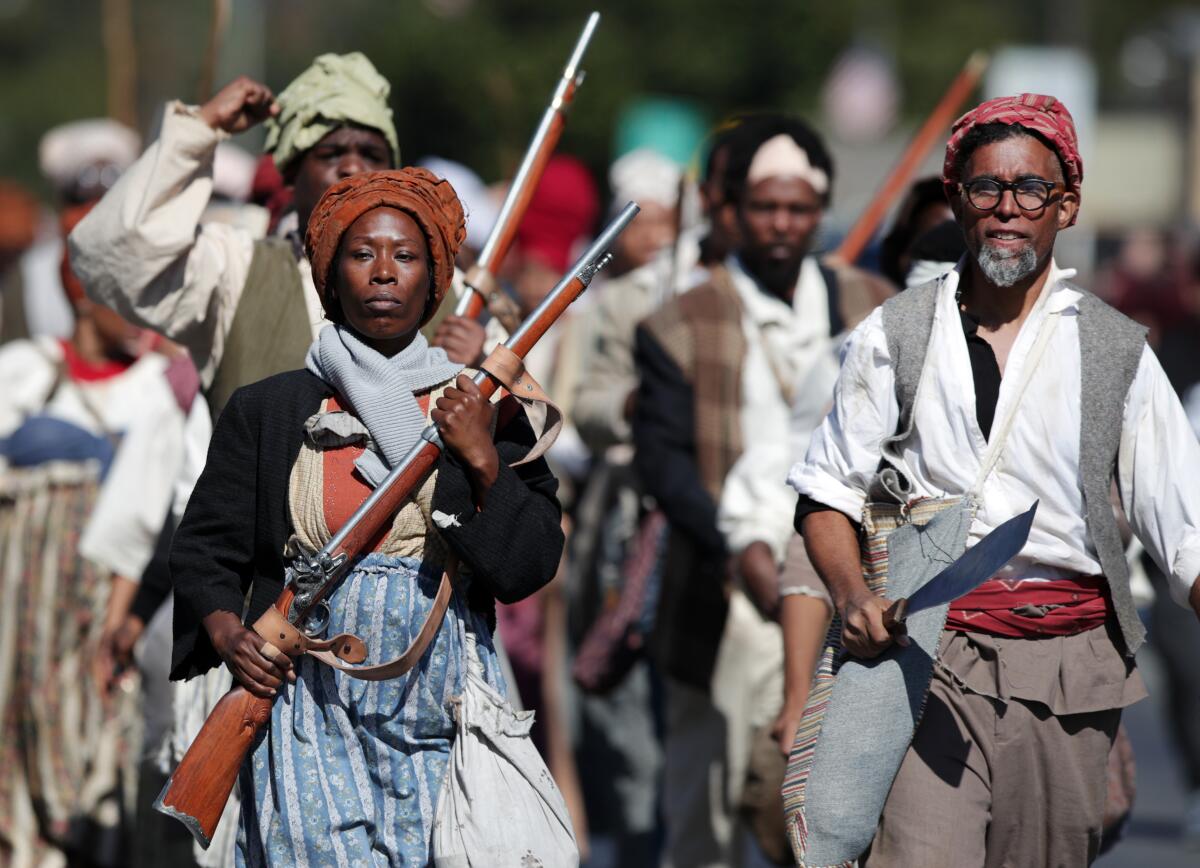
- Share via
LaPLACE, La. — First came the SUVs and golf carts. Then came the men on horseback.
Behind them, a small band of black men and women, dressed in early 1800s field pants and waistcoats, long flowing skirts and turbans, marched in tight military columns, wielding rakes, sickles and cane knives.
“On to New Orleans!” they chanted, thrusting their weapons high.
“Freedom or death!”
They were marching Friday through a tiny, mostly black neighborhood in LaPlace, a small city about 30 miles west of New Orleans, where 208 years ago enslaved black people rose up against their plantation master to challenge the institution of slavery.
Part radical history lesson, part visual spectacle, part documentary film shoot, Slave Rebellion Reenactment was conceived by New York-based artist Dread Scott, as a roving 20-mile, two-day journey that tells the little-known story of the 1811 German Coast Uprising, in which hundreds of field hands, slave drivers and house servants organized the largest slave rebellion in U.S. history.
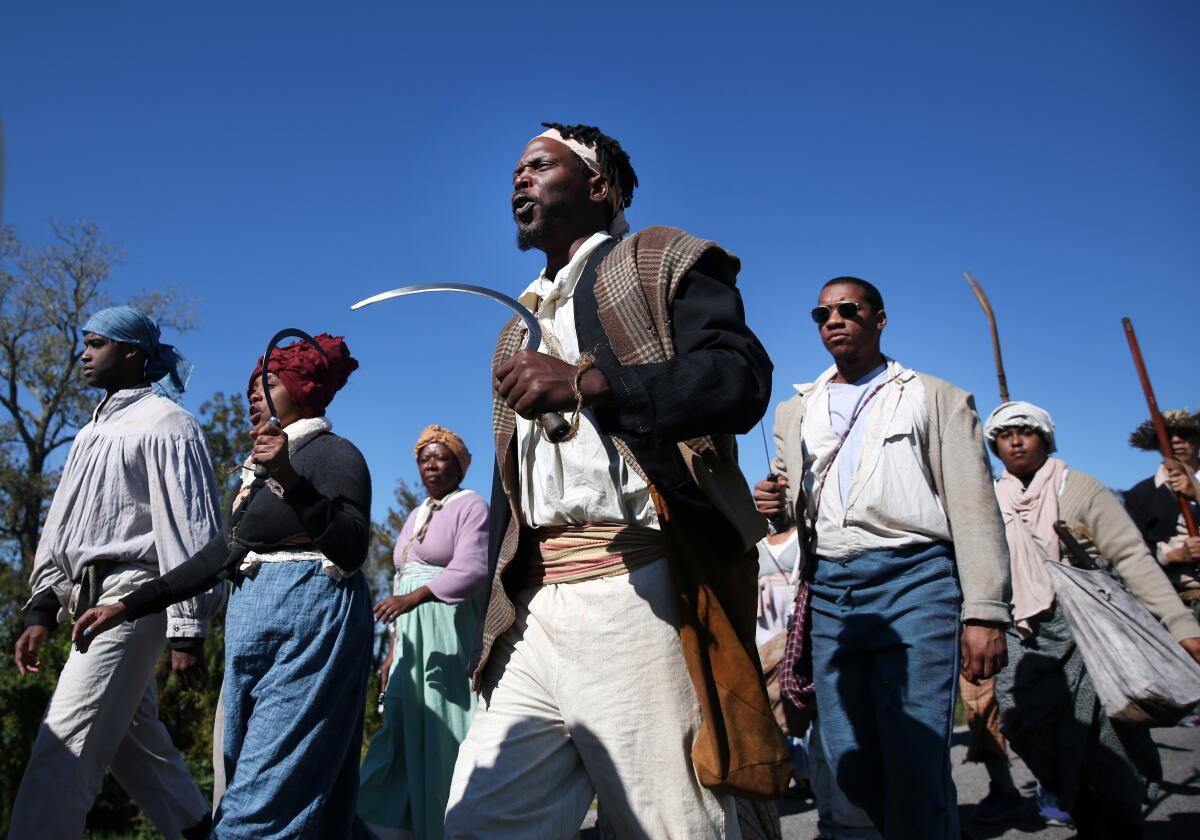
A polarizing artist who has won widespread acclaim — and notoriety — for his work on racial justice, Scott was born Scott Tyler, but goes by Dread Scott in tribute to Dred Scott, the 19th century slave who sued unsuccessfully for his freedom. His goal in reenacting the rebellion was not just to reimagine a bold but ephemeral moment in U.S. history, but to critique how the nation memorializes slavery.
“It’s a project about freedom and emancipation,” he said in an interview before the march. “People study George Washington and Thomas Jefferson, who were enslavers. Why are their ideas of democracy studied, instead of these people who were trying to get to a society that didn’t have slavery at its foundation? ... These people were heroes.”
The rebellion began on the night of Jan. 8, 1811, when Charles Deslondes, a slave overseer who was born in Haiti and brought to Louisiana by his French owners, led about two dozen slaves out of their small cabins on the Andry plantation.
The slave cabins are gone now, but the community is still home to mostly black residents.
On Friday morning, Scott performed the role of Deslondes as he stood outside Rising Star Baptist Church in the heart of Woodland Quarters, surrounded by two dozen reenactors and a scrum of documentary filmmakers, photographers, reporters and academics.
“The day we’ve been waiting for is here,” he bellowed. “Those who wish to die free, rise with me!”
As the group set off through the neighborhood, Donald August Sr., the church’s 62-year-old pastor who was dressed in salmon-colored field pants and a striped turban, hoped the spectacle would inspire pride in the community.
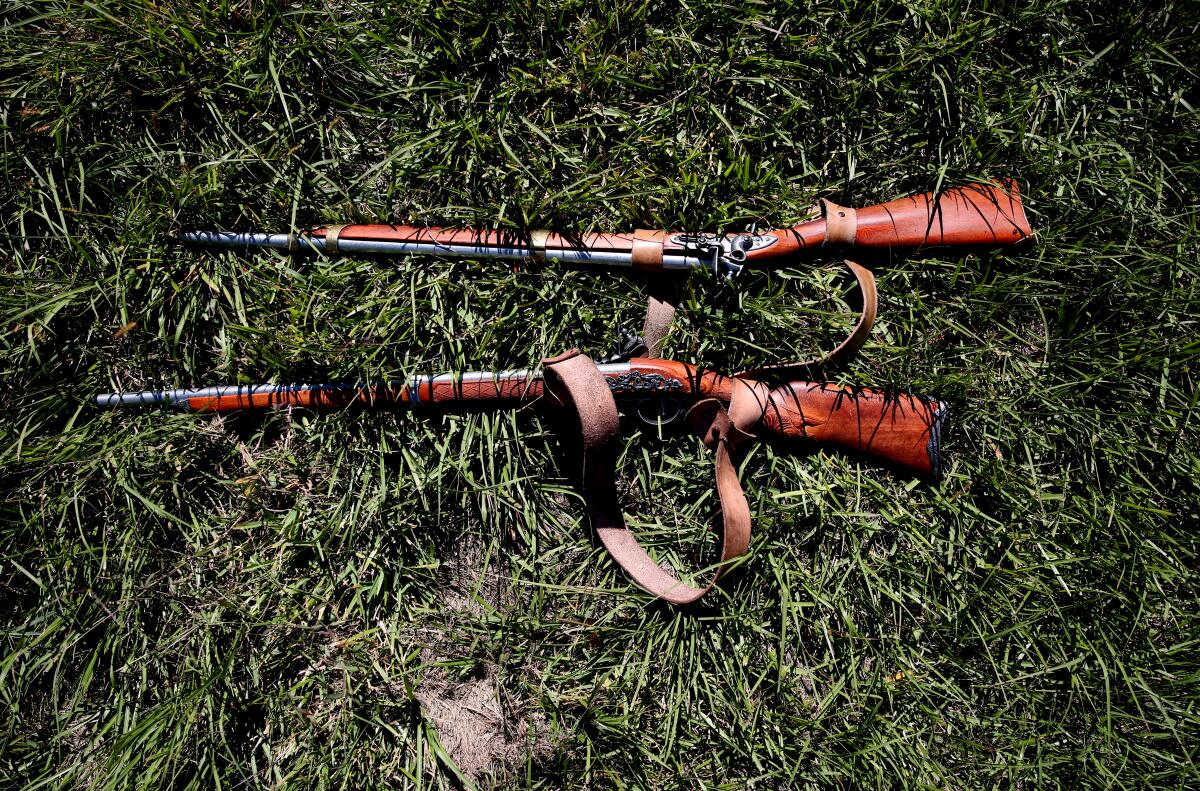
Many residents, he said, were not aware that the “Quarters” in their neighborhood’s name derived from its history as a slave quarters, or that enslaved black people struggled for freedom more than a century before the first modern-day civil rights march.
“It’s not in our history books,” he said. “This is a way to bring some kind of reflection to people’s minds.”
One of the first en route, Tyki Clayton, 18, dressed in a hoodie that said “CTB (CHASE THAT BAG),” was not thinking about history so much as his future as an upcoming rapper.
“Check me out,” he said as the costumed rebels passed. “I’m the hottest thing out here.”
Up and down the neighborhood, residents peered from the doorways of their bungalows and rusty mobile homes. Some came out to lean against chain-link fences and shoot footage from pickup trucks.
Erica Nicholas Cola, 56, who was bundled up in a black winter coat and hat, beamed as she held up her cellphone to shoot a video of the parade as it passed her mother Geneva’s house.
“It’s a long time coming,” she said.
But as the rebels cried “Join us!” the event organizers were swift to stop the public from taking part in the procession.
The sprawling mass media project, which took six years to organize, was not a conventional march or commemoration. Captured on film by Ghanaian-born British video artist John Akomfrah, the reenactment was a tightly choreographed undertaking involving a core of local pastors, students, teachers and community activists, with reinforcements of background extras and reenactors from New York and New Orleans.
Some of the most avid local champions of the 1811 uprising did not take part in the spectacle, complaining that the $1-million project funded by a string of arts organizations, was primarily a vehicle for a documentary film shoot rather than a serious attempt to inform and engage local communities.
Leon A. Waters, a descendant of the 1811 rebels who in 1996 published the first lengthy account of the uprising, “On to New Orleans!: Louisiana’s Heroic 1811 Slave Revolt,” pulled out of the march because he thought organizers missed an opportunity to engage with the descendants.
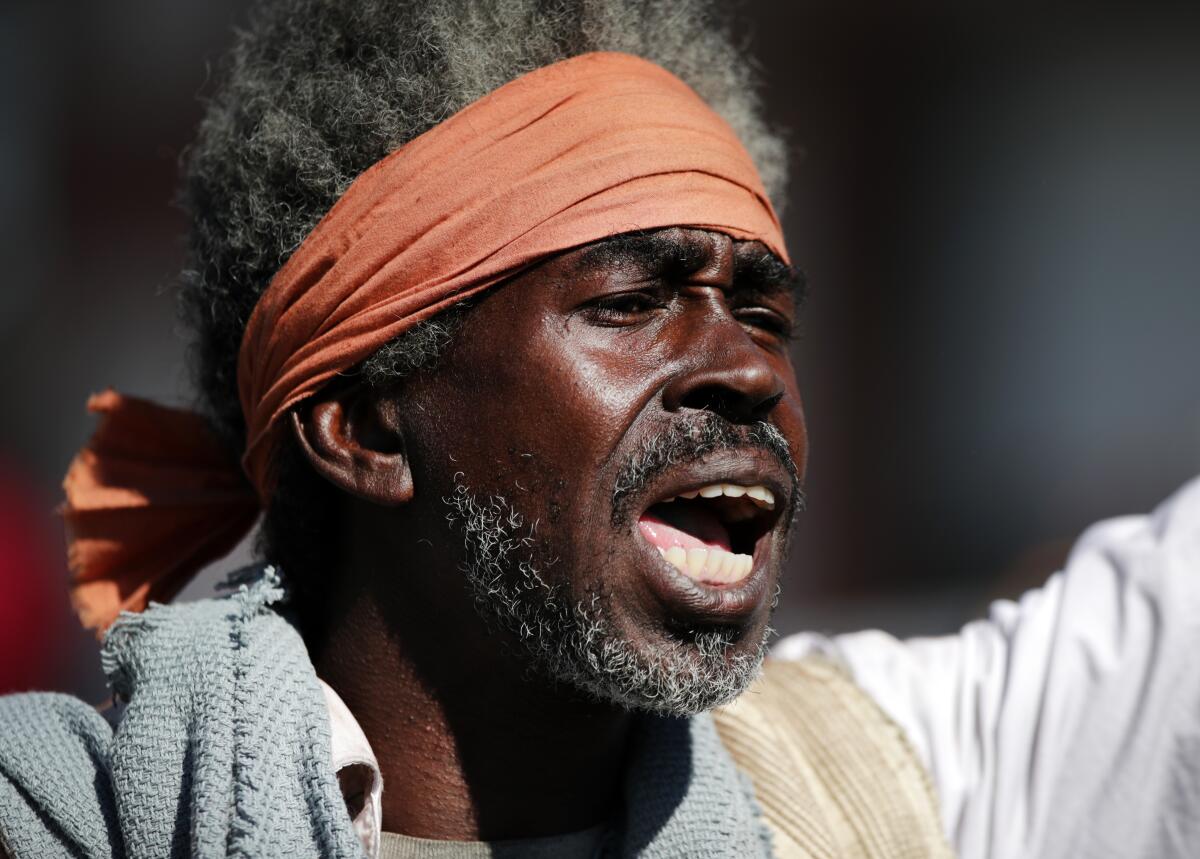
The event’s former community outreach director, Malcolm Suber, a labor activist who led the successful campaign to remove Confederate monuments in New Orleans, also backed out earlier this year, objecting to the reenactment’s focus on filmmaking.
“He is staging a film and doesn’t want anyone to be on the sidelines,” he said of Scott.
As the reenactors marched toward a Mississippi River levee, where they were met by more performers waving machetes and axes, viewers were instructed to remain behind a picket fence as the rebels stormed the slave master’s white French Creole home.
From a distance, the spectacle disappeared and all that could be heard were chants and screams. Then a white man playing Andry stumbled out of the house and was trapped on the porch by the rebels.
“Why are you doing this?” he yelled. “Haven’t I treated you with a master’s love and kindness?”
A rebel plunged an ax into his body, again and again, and he fell to the ground.
Shortly after the army left, armed with muskets seized from the house, the actor playing Andry pulled himself off the porch and made off in the opposite direction.
Historians disagree on what actually happened all those years ago. While most historical records indicate that the rebels killed the plantation owner’s son, but failed to kill Andry himself, one local historian maintains that Andry’s son died before the massacre.
The surreal procession of black SUVs with flashing blue lights, golf carts, ATVs, horses and actors playing liberated slaves continued down River Road, past a white woman standing in her yard in a bright pink bathrobe and more than a hundred students gathered outside Emily C. Watkins Elementary School with their teachers and principal.
“How far are they marching?” Jeanenne Grows, a 55-year-old U.S. postal carrier, asked as she waited for the procession to pass Azalea Drive.
Her eyes widened as she tried to stretch her mind around a 20-mile walk.
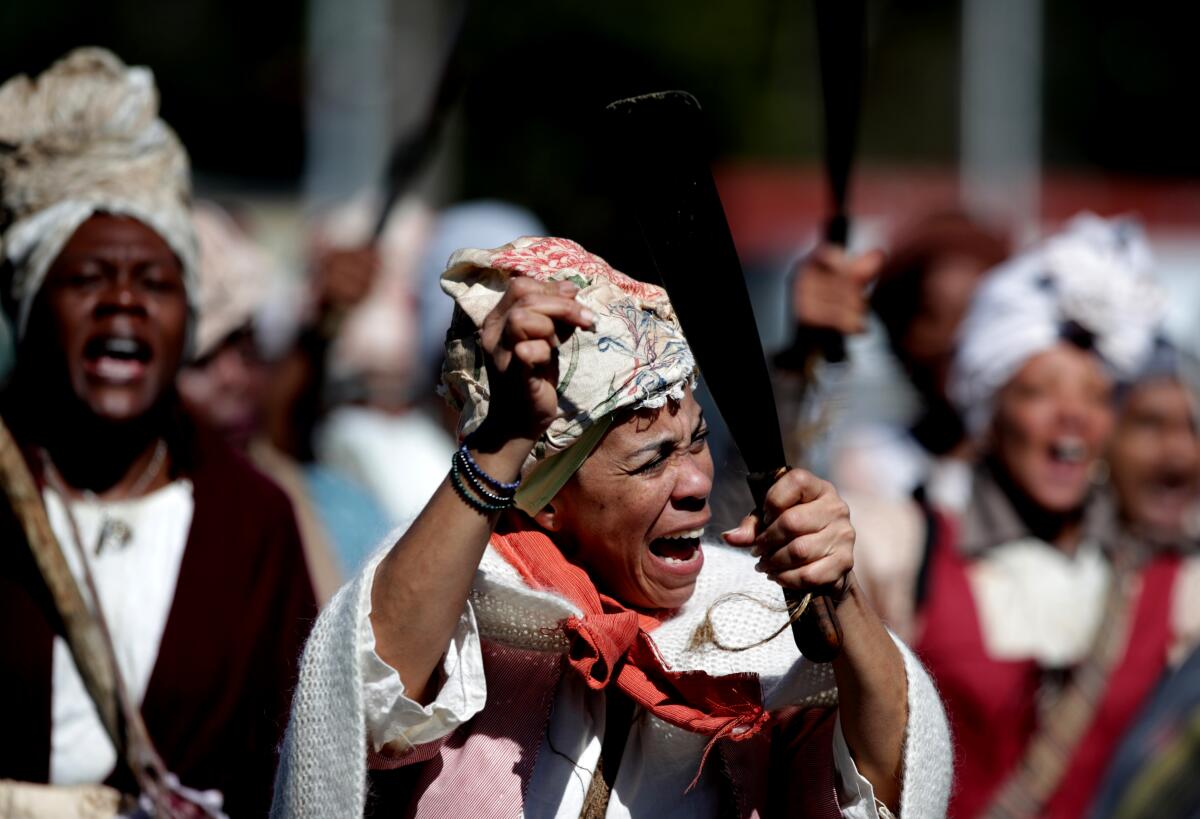
While the costumes were African, Haitian and French Creole-inspired — the products of a year of weekly sewing circles — the reenactors did not follow in the footsteps of their forebears and march barefoot or wear leather or suede slippers.
Rather, their feet were clad in Skechers, Rockport and New Balance.
Unlike the rebels, the reenactors also wore gel inserts, Band-Aids and thermal underwear. Some also wore lipstick, diamond wedding rings or fake eyelashes.
They made frequent stops, breaking formation to munch Lay’s potato chips and bananas, use porta-potties, check their cellphones, stretch in yoga poses, knit, nap and sing Southern Gospel tunes. Discussion veered from neoliberalism to the upcoming Saints-Falcons game and the Harriet Tubman movie.
Throughout, there was little vocal opposition to the march. And while some onlookers were thrilled to see the procession come through their neighborhood, most were just bemused.
A few stood silently, their arms crossed over their chests.
“I don’t know what they’re doing here,” a white woman said sharply as the army of the enslaved turned left to enter her community of two-story homes with manicured lawns. “This place didn’t exist in 1811!”
The biggest outrage was the road closure that stretched for blocks along the two-lane highway.
“What’s going on?” an elderly white woman asked as she rolled down the passenger window.
“Not a good day to do it, with all this traffic!” her husband fumed.
As the day wore on, and a harsh wind swept across the levee, some reenactors grumbled about their feet. A few left the procession to run errands or put on hoodies and smoke cigarettes.
In real life, in 1811, self-liberated slaves moved from plantation to plantation, amassing an army of between 200 and 500 as they set fire to their masters’ houses. Their goal was to link up with rebels in New Orleans.
But after two days, they were forced to retreat as a group of volunteer militia, troops and seamen approached Fortier Plantation in Kenner. Marching upriver, the rebels then encountered a militia assembled by Andry.
After a short battle, about 40 to 45 slaves were killed and the remainder slipped away into the swamps.
Many of the leaders, including Deslondes, were killed on the spot. Some were put on trial and executed, their heads chopped off and placed on poles along the river as a warning to other slaves.
But that is not how the Slave Rebellion Reenactment decided to end the story.
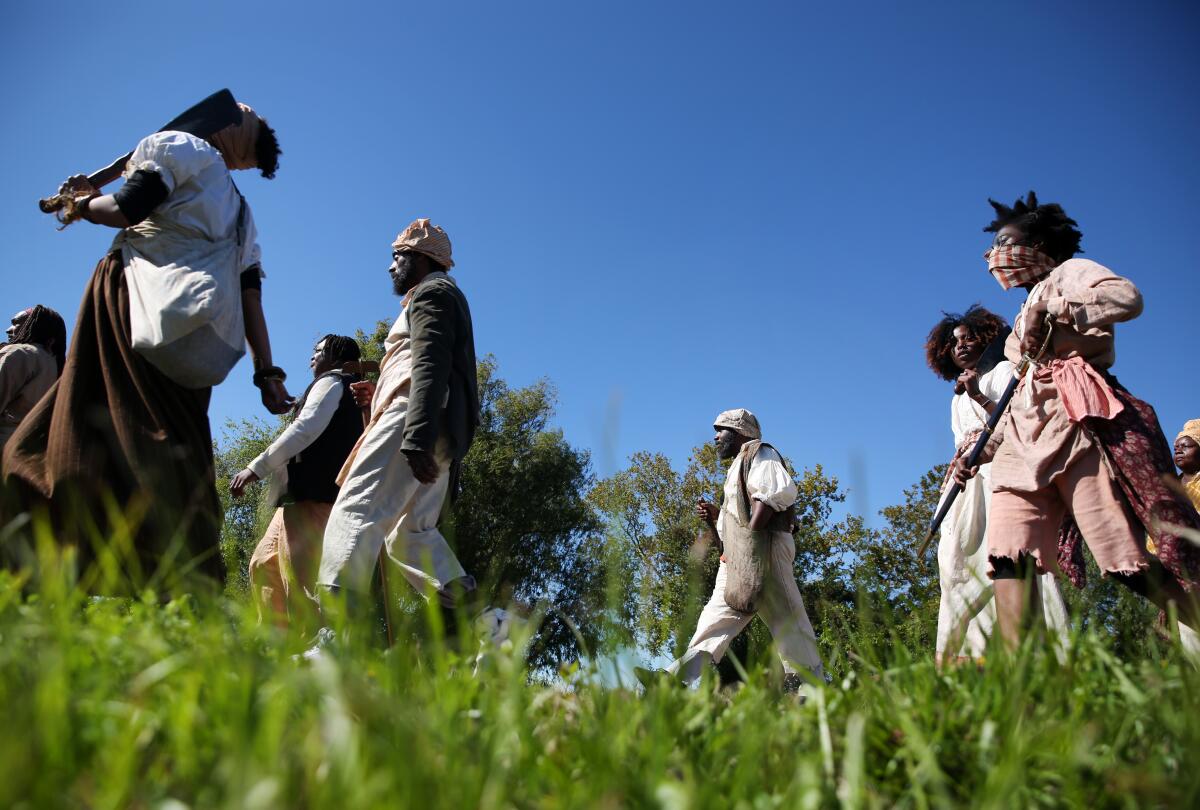
As the sun set and the sky turned dusty pink, a crowd of more than 100 spectators stood on the Bonnet Carre spillway Friday evening as the white militia appeared, dressed in red and blue frock coats with tall hats with gold tassels and white plumes.
A group of about 20 liberated slaves marched toward them, backed by a larger group chanting, “Freedom or death!”
After an exchange of gunfire, the militia scattered and retreated, and the army of the enslaved’s chant turned into a joyous call-and-response singsong.
We’re going to end slavery!
We’re going to end slavery!
On to New Orleans!
On to New Orleans!
On Saturday morning, the sun was shining as the reenactors picked up the march.
The antique army marched along the levee along the Mississippi, where the sprawling sugar plantations have been replaced by trailer parks and subdivisions, hulking steel and petrochemical plants. Nicknamed “Cancer Alley,” the region has one of the highest cancer rates in the nation.
Marching past the towering catalytic cracking towers and vast oil drums of a Shell petrochemical plant in Norco, Sonita Singh, an assistant professor of public health at Louisiana State University, considered the reenactment an opportunity to “recontextualize neocolonialism.”
“It’s wanton, absolute greed — the same greed that drove the slave trade,” she said as she stood on the levee during a break. “This makes that stark reality very clear.”
After marching past the historic Ormond and Destrehan plantations, strip malls and a Popeyes, the reenactors clambered onto buses that whisked them to New Orleans’ French Quarter.
In 1811, it was the site of Fort St. Charles, the city’s largest fortification.
“Freedom!” they shouted as they marched through the city’s thronging tourist and entertainment hub in a military-style second-line parade, bewildering tour guides and tipsy revelers holding plastic cups of hurricane rum drinks.
When they reached Congo Square, the location where Africans gathered on Sundays to sing and dance, they were welcomed by a brass band, drummers and Mardi Gras Indians in lavish costumes of purple feathers and sequins.
One by one, the reenactors took to a stage where, in a riff of Janelle Monáe’s protest anthem, “Hell You Talmbout,” they chanted the names of the leaders of the 1811 revolt. Most are known only by their first names.
Gilbert.
Say his name!
Jupiter.
Say his name!
Jessamin.
Say her name! Say her name! Say her name!
More to Read
Sign up for Essential California
The most important California stories and recommendations in your inbox every morning.
You may occasionally receive promotional content from the Los Angeles Times.














